
How to Write Effective OKRs & OKR Examples by Role
Writing effective OKRs is not as complex as you might think if you follow a simple and straightforward formula.
Executive Summary:
Writing effective OKRs is not as complex as you might think if you follow a simple and straightforward formula.
Some of the most common questions that people ask in relation to OKRs are:
Are OKRs effective?
Are KPIs useful?
Do OKRs really work?
Should I use OKRs?
Our short answer is yes. Objectives and key results, or OKRs, have become one of the most popular and widely used business performance frameworks for organizations and teams that want to measure the success of their work.
If you want to align your projects and tasks to the overall vision of your organization, then it is crucial to implement OKRs. Since we believe in the power and the benefits that OKRs can bring to an organization, it is worth talking about how to write effective OKRs; the topic on which this article will focus on.
What Is an OKR and What Is It For?
The acronym OKR stands for ‘’objectives and key results’’ and is a goal-setting and leadership framework used by organizations, teams, and individuals to set challenging, ambitious goals with measurable results. OKRs are used to bridge the gap between strategy and execution and move from an output to an outcome-based approach to work.
The ‘’O’’ (objective) part of the OKR framework is about what the desired final result is, while the ‘’KR’’ (key results) part are the metric-driven goals you need in order to achieve your objectives. The OKR framework is not complete without initiatives. Initiative in the OKR framework refers to the projects and tasks that will help you achieve your key results and contribute to your objective success.
Why Should You Use OKRs?
If you don’t set objectives for your organization then where are you headed? How are you going to improve and start making smarter decisions to grow your business? That is exactly what OKRs help you to do. OKRs are straightforward statements that are clearly defined, specific and measurable so you can easily track and monitor their progress. OKRs also prevent goals and priorities from overlapping by aligning them with the overall organization’s objectives.
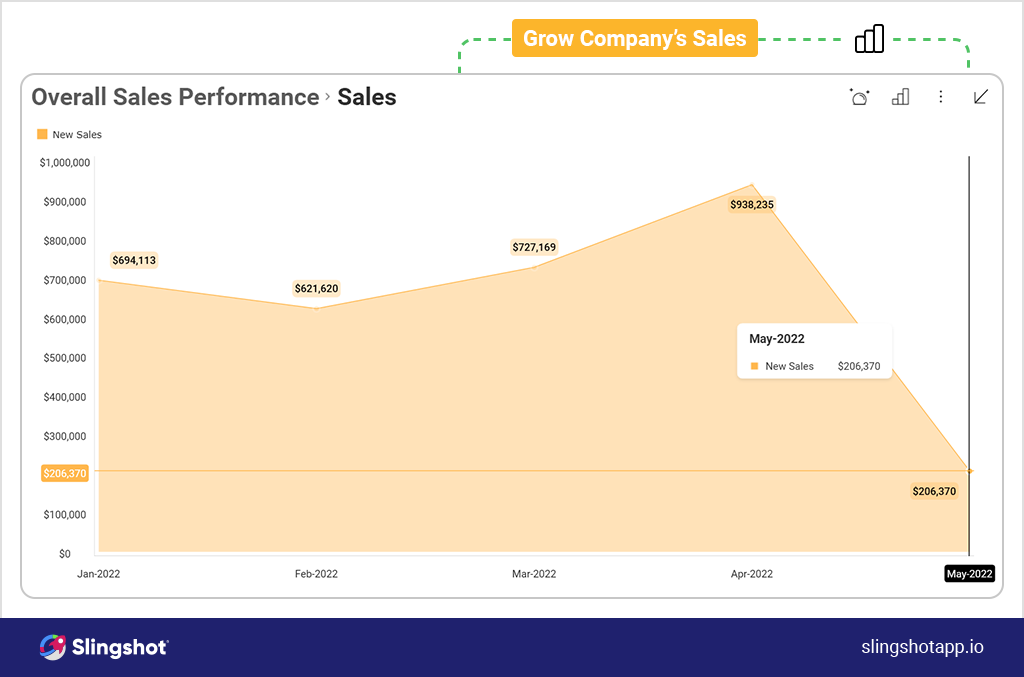
Another benefit of OKRs is that they are not written in stone; OKRs respond to change, and you can adapt, revise, add or delete them where and how you see fit.
What Is the Difference Between KPIs and OKRs?
KPI (key performance indicator) is another business performance framework that is used to measure and evaluate how successful an organization is in achieving its key business objectives. And although both performance frameworks are very similar in many ways, there are some key differences between KPIs and OKRs.
While KPIs are used to measure success and focus on the final results, OKRs are used to set the desired outcome and are concerned with the entire process. KPIs are used to improve a certain project within a department (ex. Reduce the cost per lead in the sales department), whereas OKRs speak to the larger vision of the organization’s goals.
KPIs are what help you drive your OKRs, so you should use both performance tracking techniques simultaneously to stay on focus, improve your performance and ultimately reach your organization’s business goals. OKRs are what help you define your business goals and identify paths to achieve them, but KPIs are what you’re using to actually measure the performance of your activities against these goals.
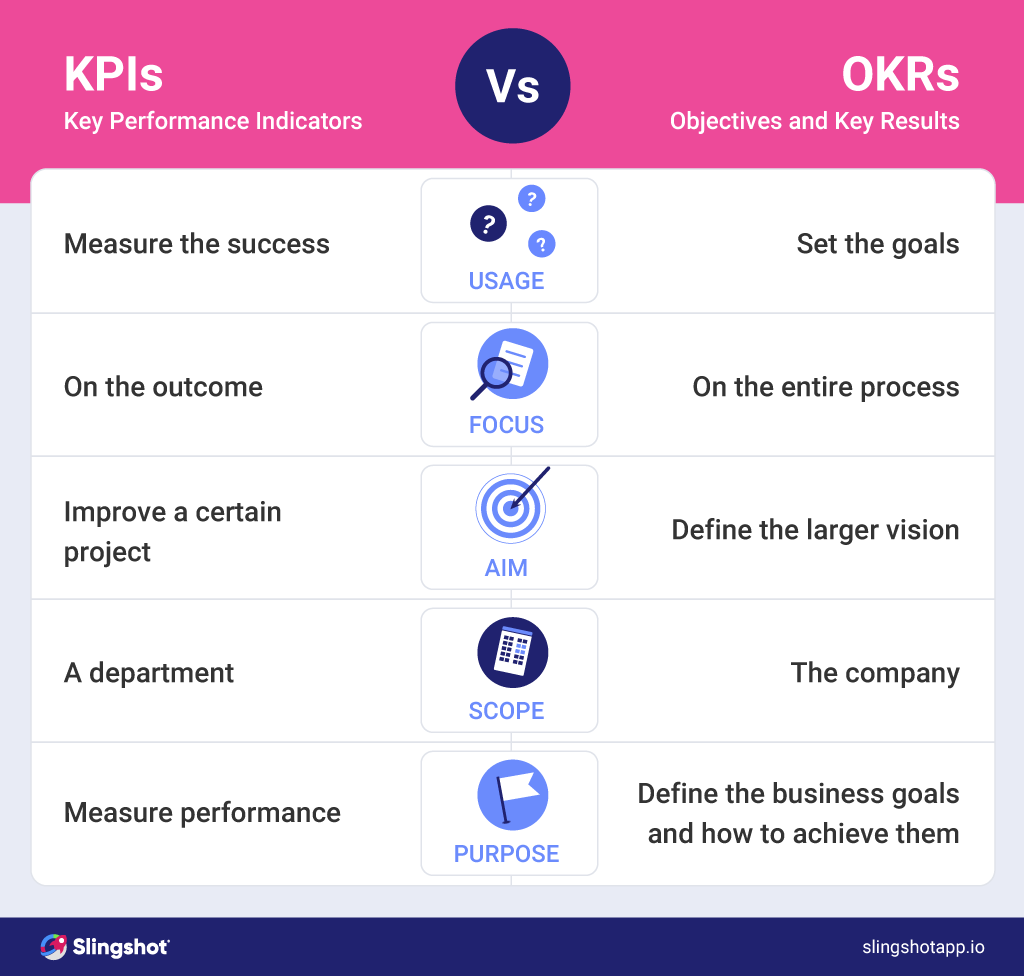
How to Write Effective OKRs?
And now that we know what an OKR is, what is it for, why you should use OKRs, and what is the difference between KPIs and OKRs, we’ve come to the most essential part – how to write effective OKRs.
Writing effective OKRs is not as complex as you might think if you follow this simple and straightforward formula:
OKR = (Objective = What) + 3x (Key Results = How)
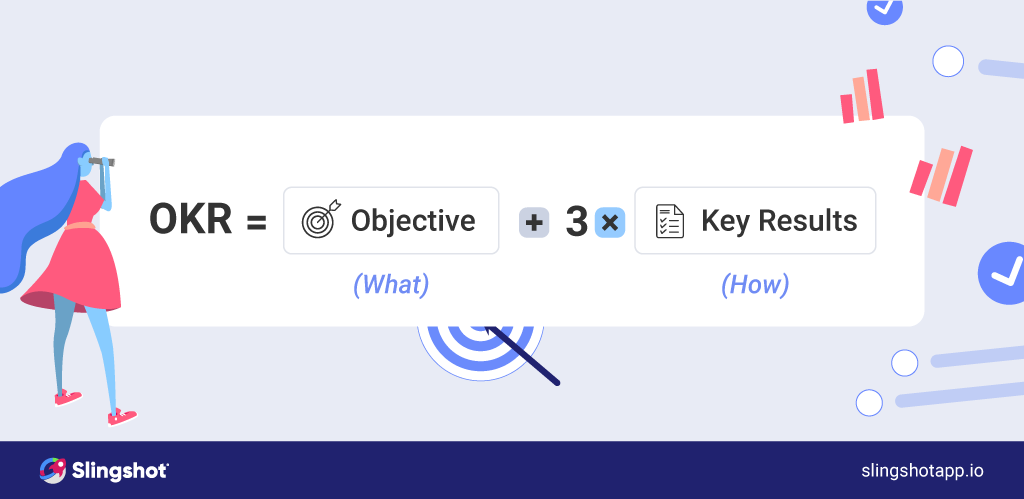
I will ____ as measured by ____.
But, of course, apart from following this formula, there are a couple of more things to know for effective OKRs writing. Always keep in mind and write OKRs that are:
Clear – OKRs need to be clear and digestible so that everyone from your team can understand them. Both the objective and the key results should be straightforward and show what you’ll be tracking without the need for an explanation.
Challenging / Ambitious – Writing effective OKRs is not the time to lower your expectations. Think BIG and beyond what you think you can accomplish. Even if you don’t hit that 100% mark, you’re still going to make progress.
Time-bound – Every objective needs a target date, and a deadline to focus on and work toward. This gives a little sense of urgency so that your team doesn’t start postponing the OKRs in the future.
Measurable – If you’re OKRs aren’t measurable, it is going to be quite difficult to understand how you are progressing and if you’ve been successful. And if you don’t know that, how will you know if your OKRs are effective? Get it? It is a vicious circle. So, please make sure your OKRs are measurable.
Consistently reviewed – Make reviewing OKRs part of your weekly progress meetings, discuss the progress, and if necessary, adjust.
How to Write Effective OKRs in 6 Easy Steps
1. Understand your organization’s goals
Writing effective OKRs starts with understanding your organization’s goals first; otherwise, where do you start? Once you have a clear vision of what you want to achieve in the long run, as well as in the near future, you can break your goals into actionable OKRs.
And remember that OKRs shouldn’t be set in isolation; they should all ladder up and contribute to the same overall organization vision and goals.
2. Prepare draft objectives and share them with your team
Create a draft of objectives to share with your team for their feedback. Don’t forget that you’re not an expert in all areas and sometimes what you think might be achieved at the speed of light might be a longer and more complex process and vice versa. Your team is the people who will be working towards these objectives, so it is important that they get involved in the process of setting realistic OKRs.
3. Choose your company’s objectives
By getting to this step, it should be clear and easy what objectives you should set for your organization’s goals. Don’t set too many- focus on the most important in the beginning and after you achieve them, move to the next ones.
4. Involve your team in a brainstorming session
The next step in writing effective OKRs is more than sharing your objectives’ ideas. By conducting a brainstorming session with your team once you’ve decided on your objectives, your team can have very useful and valuable input on what key results might actually help you achieve them. Also, brainstorming sessions usually engage and inspire your team to care about the organization’s OKRs as much as you do, driving accountability, and ownership.
5. Define your key results
Defining your key results is equally important as setting your objectives. Sometimes it can be tempting to start with the results, but you have to remember that the objectives are what guide the key results, so they should be established first.
The key results are the map to getting to your destination (objective) and should be relevant and easy to measure.
You would like to include your team in the step of writing effective OKRs too. As they are experts in their own areas, they will know best what results would work the best for achieving a given objective.
6. Plan your initiatives
The final ingredient to the ‘’effective OKRs’’ recipe is initiative. Your objectives are your final destination, the key results are your path to get there, and initiatives are the actual work you’re planning to do. Initiatives must be specific and realistic (you have to have the power to complete them).
4 Common Mistakes to Avoid When Writing OKRs
1. Setting unachievable goals
The number one mistake that people make when writing their OKRs is setting unachievable objectives. It’s one thing to be ambitious and to set challenging goals, but the idea is to push your team further and not demotivate them. Setting objectives that are unrealistic and impossible will only cause frustration and nothing more.
2. Having low-value objectives or too many objectives
If you have too many objectives, you have none. Your team will lose focus, become overwhelmed, and will ultimately fail. It’s better and easier for teams to achieve extraordinary results with fewer objectives.
Another common mistake is setting OKRs that don’t promise any clear business value. Low-value OKRs will be different for each organization but are typically objectives that even when achieved no one will notice or care about. It isn’t worth wasting your time and resources when there are more important things to focus on.
3. Not assigning a directly responsible individual (DRI)
For any OKR, there must be a person directly responsible for completing it. Failing to assign responsibilities to the right people could allow frustrations and a lack of discipline in the workspace. Assign one person to each OKR and hold them accountable for the progress and completion of the objective.
4. Failing to track progress
To stay consistent with progress, you have to review it and discuss it weekly. Many leaders fail at doing that as OKRs are so easy to track that they often lose discipline in doing so and leaving things on autopilot. Avoid this mistake by encouraging your team to aim for 100% completion each week. Using a tool like Slingshot ensures that the work of all team members remains on focus and is aligned to the objective.
OKR Examples by Team Function
So, as we already discussed above, OKRs have two components, the Objective and Key Results. Objectives are typically short, memorable, and qualitative descriptions of what you want to achieve – no more and no less. They are concrete and action-oriented. Key results benchmark and monitor the process of getting to the objective. As a rule of thumb, the key results are specific, time-bound, measurable, and typically of a quantitative nature.
For each objective, you should have a set of 2 to 5 key results and when you are setting them, you should follow the S.M.A.R.T. goal-setting method. Here are some good OKR examples for a variety of different roles within an organization:
CEO OKR Example
Objective: Grow top-line revenue
Key results:
- Grow to 5,000 active paying customers by EOY
- Close $5M in net revenue for this year
- Increase marketing team budget by 10% per month
Project Manager OKR Example
Objective: Improve collaboration and communication across teams, one of the top project management goals
Key results:
- Hold 2 meetings per month to communicate expectations clearly and set clear roles and responsibilities
- Set up a weekly progress meeting with each team
- Complete 90% of projects on time this year
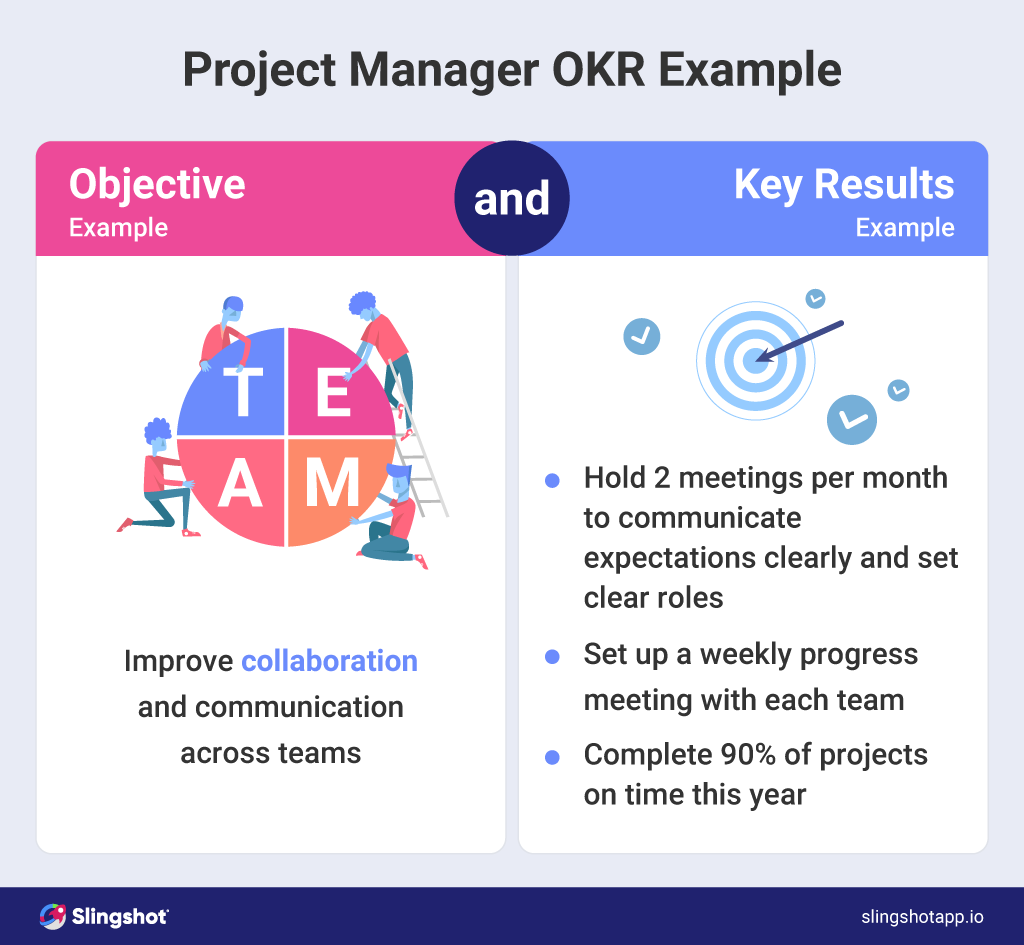
Sales Manager OKR Example
Objective: Grow the company’s sales
Key results:
- Increase scheduled calls per sales rep from 3 per week to 6 per week
- Grow average deal size from $1,000 to $1,250
- Increase close rate from 17% to 21%
Account Manager OKR Example
Objective: Upsell new features
Key results:
- Create 3 different offers and run an A/B test to identify the best-performing offer
- Pitch 100 active customers by the end of the quarter
- Sell 30 subscriptions and generate additional $10,000 in revenue
Software Engineer OKR Examples
Objective: Improve the company’s product code quality
Key results:
- Fix 5 bugs this quarter
- Increase the code coverage to 90% on {X project} this quarter
- Refactor 2 areas of code you didn’t initially create
Web Developer OKR Example
Objective: Build a prototype of the company’s new app
Key result:
- Prioritize features to build and build 5 most important features
- Test the app, deploy it to production and drive the first 50 users
Customer Success Manager OKR Example
Objective: Increase NPS score from 8 to 10
Key results:
- Get feedback from 100 active customers on product improvements
- Conduct 20 phone calls with active customers
SEO Manager OKR Example
Objective: Improve on-page SEO
Key results:
- Include 5 internal links per blog post
- Identify and fix 100% of broken links
- Write descriptive alt text for 100% of the images on the blog by the end of this quarter
Content Manager OKR Example
Objective: Build trust with the company’s targeted audience
Key results:
- Create 5 customer success studies to increase trust for incoming leads
- Update 100% of the product pages to reflect the complete offering
- Appear on 10 new product recommendation lists by the end of the quarter
UX Designer OKR Example
Objective: Create a series of design sprints to document, track and improve UX
Key results:
- Run 3 design sprints to improve the company’s product onboarding experience
- Run 3 design sprints to improve the company’s product cancelation experience to reduce churn
How Can Slingshot Help You With Setting Up and Tracking OKRs Effectively?
Slingshot is an all-in-one productivity tool designed to help teams and organizations produce extraordinary results by improving workflow efficiency with a rich and robust set of integrated features, aligning teams around opportunities to encourage them to reach their full potential and enable smart, data-driven decision making with advanced analytics.
At the heart of Slingshot is the concept of data-driven decision-making and organizational culture. Slingshot has been designed to help teams stay on top of current data for campaigns, through dashboards, KPI and OKR tracking, and KPI indicator spreadsheets that are converted into data analytics which are then easily shared. It also offers a set of statistical functions that allow you to receive more insights from your visualizations.
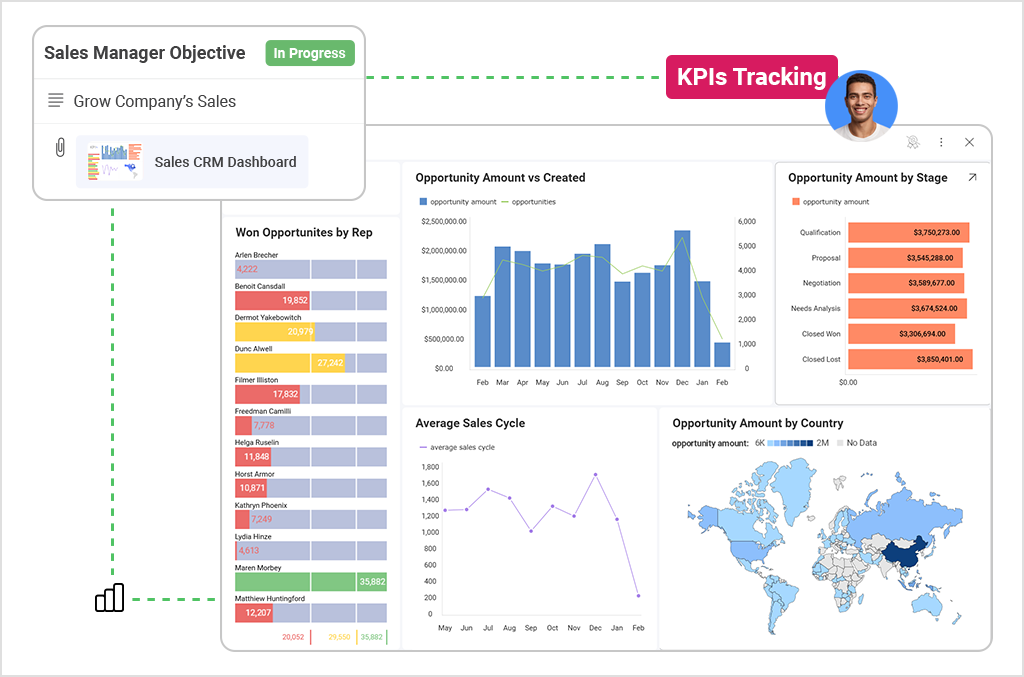
Slingshot gives managers and team members visibility into the entire work process, connecting everyday tasks to the project’s most important objectives. It also seamlessly integrates with leading analysis tools so you can track and grow your KPIs with each campaign.
Interested in learning more? Try Slingshot for free and see for yourself how it can help you leverage actionable insights all while making it easier for your team to utilize data, cultivate a data-driven culture and improve productivity.
Related Articles
Ready to grow your business 10x with AI decision-making?
Request a Free Demo of SlingshotSHARE THIS POST




 Return to Blog
Return to Blog


